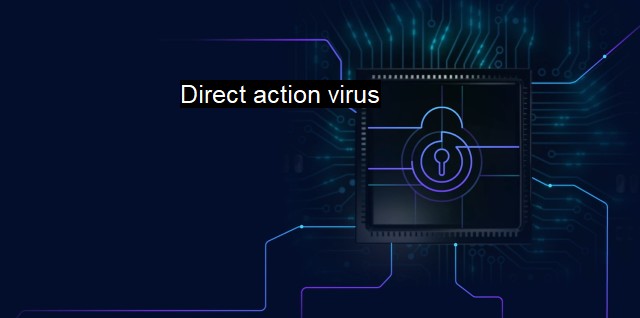What are Direct action virus?
Exploring the Mechanics and Resiliency of Direct Action Viruses in Computer Malware: A Deeper Dive
A Direct Action Virus is a type of computer virus that operates with classified by its unique method of operation and specific set of targeted files. Understanding the characteristics of such a virus is essential in examining its impact on compromised systems and defining strategic ways to combat, manage or mitigate potential attacks.What sets the Direct Action Virus apart from other forms of computer viruses is its execution process. Most viruses embed themselves into the host's operating system, allowing them to repeatedly replicate and reap havoc over extended periods of time. Contrarily, the Direct Action Virus typically operates by selecting particular file types and infecting these directly, rather than installing itself in the system's memory.
Once it infects these files, the Direct Action Virus distributes its duplicate copies across the entire filesystem. This course of action is deployed when an infected program or file becomes executable or is run by an unsuspecting user, hence, the virus’s name, “Direct Action.” This type of virus doesn't stay on the system's memory after it fulfills its purpose, which earns it the attribute of being less hazardous than most forms of malware.
That does not mean its impact should be taken lightly. Direct Action Viruses have the power to delete, corrupt, or alter the files they target, greatly inconveniencing users by causing loss of data, impacting productivity, and potentially causing fiscal losses for organizations. Other consequences can include slower computer performance, reduced internet speeds, and unauthorized access to or theft of personal information.
It is found that Direct Action Viruses most commonly target executable/compressed files; these often include .exe and .zip file formats, which are prevalent data types in typical computer systems. Once these files are utilized, the virus activates, duplicates, infects other similar files, and then vanishes once the damage is done.
An incredibly deceptive characteristic of the Direct Action Virus is its ability to appear dormant. The virus can copy itself onto a system without manifesting any symptoms, silently hiding among legitimate software code. Its self-preservation approach ensures any changes are barely noticeable until significant damage is already done to the system files.
When it comes to protection strategies, the most effective method is to ensure a reliable antivirus software is installed on all computer systems. These should be adept at detecting, quarantively, or removing Direct Action Viruses or any form of malware in general. Frequent and automatic updates to the antivirus software can also help to prevent the latest evolutions of the virus.
It is equally crucial that users exercise discretion while downloading files or opening attachments, especially from unfamiliar sources. Files should always be scanned before opening, minimizing the risk of triggering the sequence that gives the virus 'direct action.'
While the Direct Action Virus may appear less threatening than memory-based viruses, it should not be taken lightly. It still poses a significant risk, particularly when lying latent on a host machine. Defensive protocols like updated antivirus software and safe browsing practices are invariably the best strategy in combating the Direct Action Virus. Both lay users and enterprises need to arm themselves with the utmost comprehension and preventive methods to ensure the stability and security of their systems.

Direct action virus FAQs
What is a direct action virus?
A direct action virus is a type of virus that is specifically designed to take action immediately upon infection. This virus typically seeks out and destroys files and data on the computer system that it has infected.How does a direct action virus differ from other types of viruses?
While other viruses may remain hidden on the infected system, transmitting data back to the attacker or replicating themselves across the network, a direct action virus takes immediate action upon infection. It is more aggressive and destructive than other types of viruses.What are some common symptoms of a direct action virus infection?
Some common symptoms of a direct action virus infection may include missing or corrupted files, slow system performance, frequent crashes or freezes, and unusual error messages.How can I protect my computer from direct action viruses?
To protect your computer from direct action viruses, it is important to keep your antivirus software up to date and to use caution when opening emails or downloading files from unknown sources. Regularly backing up your data to an external hard drive or cloud storage can also help you recover your files if your computer does become infected with a virus.| | A | | | B | | | C | | | D | | | E | | | F | | | G | | | H | | | I | | | J | | | K | | | L | | | M | |
| | N | | | O | | | P | | | Q | | | R | | | S | | | T | | | U | | | V | | | W | | | X | | | Y | | | Z | |
| | 1 | | | 2 | | | 3 | | | 4 | | | 7 | | | 8 | | |||||||